Did you know there are over 30 species of foxes? Foxes can be found in almost every region in the world and the red fox is one of the most widely dispersed animals on the planet.
There are over 37 types of foxes. Only 12 of those species are considered true type foxes of the Vulpes genus. They exist on multiple continents and live in many regions. The red fox is the most common type of fox.
Watch Types of Foxes Video
Subscribe to our Youtube Channel for weekly videos!
Fox Scientific Classifications
The 12 true type species of foxes all fall into the Vulpes genus, however, there are some foxes such as the Gray fox that have a different genus altogether. All foxes are canids and come from the same animal family.
| Kingdom – | Animalia |
| Class – | Mammalia |
| Family – | Canidae |
| Genus – | Vulpes |
| Order – | Carnivora |
Each fox has a different species name, and while not all foxes are of the same genus they all have the same relatives.
What Are Foxes Related To
Foxes are related to wolves. It was once thought that foxes were related to dogs, being further down the line, however, in recent times ancient fossils of foxes have been found alongside wolves that suggest foxes are much older than science originally suspected.
At some point, foxes split away from wolves and evolved differently than dogs. This can be found within the unique features that foxes possess such as vertical pupils and partially retractable claws.
Many people once thought foxes were related to cats since they share many similarities with foxes but they are not. Foxes are strictly from the Canidae family.
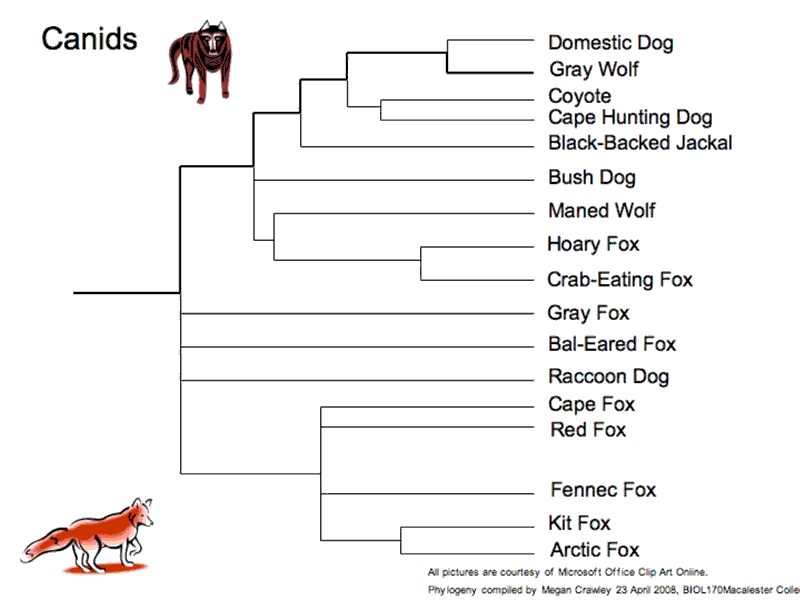
12 True Type Foxes
There are 12 true type species of foxes that all fall under the Vulpes genus. These foxes live in many places around the world. They have different shapes, sizes, and fur colors but they are all related.
Many subspecies of foxes branch off of the Vulpes genus and have adapted well to their surroundings.
The 12 true type species are as follows:
| Red fox | Arctic fox |
| Fennec fox | Bengal fox |
| Pale fox | Blanford’s fox |
| Cape fox | Corsac fox |
| Rüppell’s Fox | Kit fox |
| Tibetan sand fox | Swift fox |
Foxes that are not in the true type genus are still foxes, despite their having a different classification.
Let’s take a closer look at each of the 12 true type foxes.
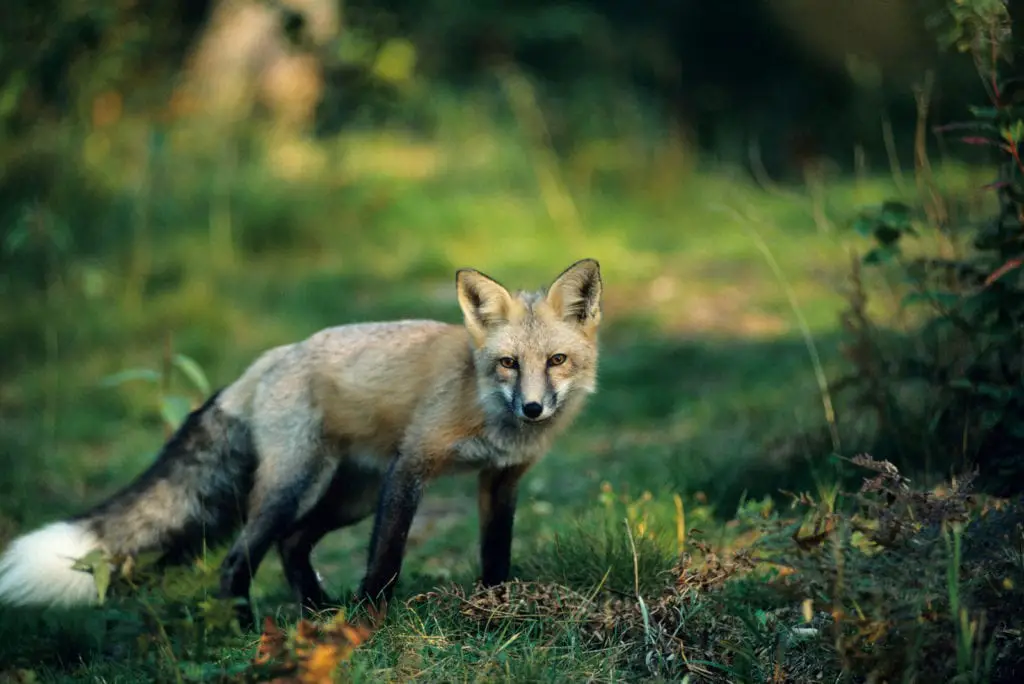
Red Fox
The red fox (Vulpes vulpes) are the most widely dispersed species of all of the canids. They are found in almost every northern region around the world. They have moved further south ending up in parts of central American, Africa, and Asia.
There are subspecies of the red fox, such as the red foxes that live in Japan (Vulpes vulpes schrencki).
Red foxes have many color morphs and their fur changes color when they lose some of their guard hairs in spring in preparation for the warm months.
They feed mostly on small game mammals, vegetation, fruits, and some insects.
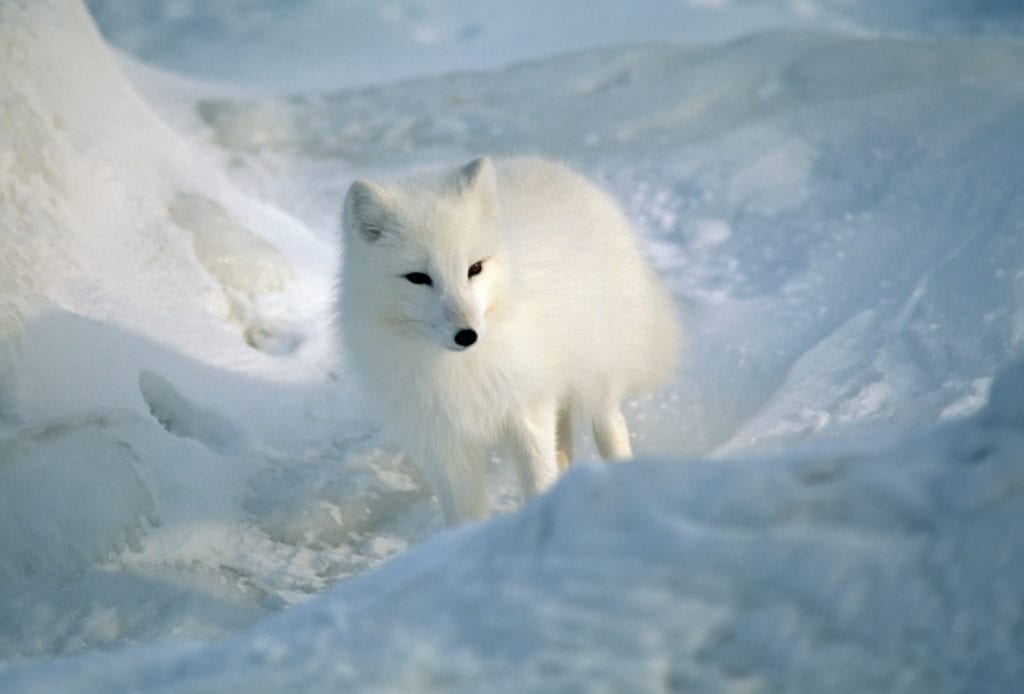
Arctic Fox
The arctic fox (Vulpes lagopus) is found in the arctic regions of the world. This includes Eurasia, North America, Iceland, and Greenland. They are monogamous and mate for life. They make their dens in the sides of cliffs and they do not hibernate during the winter.
The pads of their feet have thick fur that helps them not to get frostbite. They have two main color morphs, the blue arctic and the white arctic. The white color is the most common and the blue arctic is a brown or charcoal gray color.
The arctic fox’s main food source is lemmings and other small mammals such as rodents. They are opportunistic and will feed on whatever is available to them, this includes carrion (animal carcasses). They also eat vegetation and will make their spring dens close to vegetation.
Fennec Fox
The fennec fox (Vulpes zerda) is a desert fox that is found primarily in the deserts of Africa. They are the smallest of all of the fox species. Fennec foxes have large ears that allow them to listen for prey and predators.
They build large dens around boulders and dense sand that usually have 8-10 openings and will oftentimes have large family units. They thrive in the desert and in recent times have been carried into the exotic pet industry.
Fennec foxes have adapted to the heat in many ways, to cool themselves down they pant with thousands of breaths per minute. Their large ears also help to cool their body.
Fennec foxes mainly feed on insects, they also feed on rodents and vegetation. Their diets consist mainly of silkworms, scorpions, and reptiles. They store and cache food by burying it.
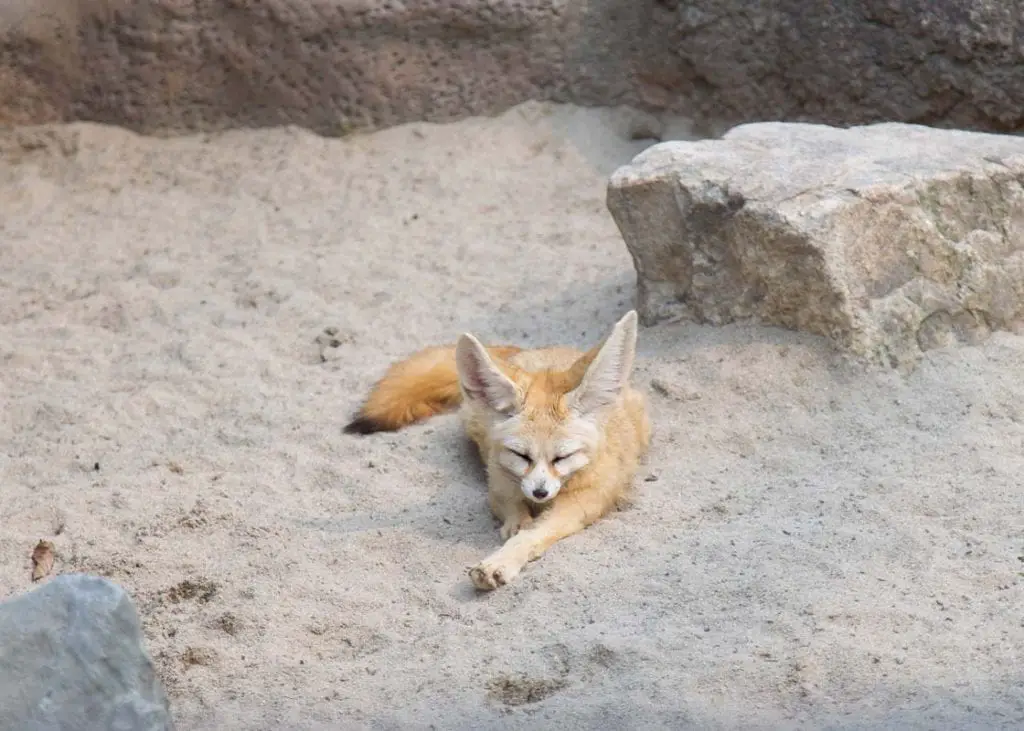
Pale Fox
The pale fox (Vulpes pallida) is another of the desert foxes and lives in northern regions of Africa such as Sudan and Somalia. They live in the dune and grassland areas of Africa. Pale foxes make deep dens in the earth, picking areas that have some vegetation.
They live in family units consisting of 3 foxes. They are a small to medium fox that is tan in color, with some hints of salt and pepper color. They sometimes have a black ring around their eyes.
Their diet consists of small mammals, rodents, lizards, insects, birds, and eggs. They are oftentimes confused with fennec foxes because they are the same colors and from similar regions in Africa.
Blanford’s Fox
The Blanford’s fox (Vulpes cana) is a desert fox that lives in Israel as well as parts of Afghanistan and other middle eastern countries. Blandford’s foxes live in regions that have lots of rocks and cliffs and make their dens there. They prefer higher elevated mountain ranges.
They are similar to the shape and size of fennec foxes, being a little bigger. Their ears are large like some of their desert cousins. The ears help them to cool off in the eat as well as listen for prey and predators.
Their range crosses many countries in the middle east and they have a large population in these areas. They eat mainly insects and some fruit. Their diets consist of beetles, grasshoppers, fruits, and some small mammals such as rodents.
Cape Fox
The Cape fox (Vulpes chama) is a desert fox found in the Saharan regions of Africa. They are one of the only foxes in Africa known to live under the equator. Their colors are gray with salt and pepper tones. Cape foxes prefer to make their dens in semi-desert areas and stay away from forests.
They are nocturnal and they forage separately, the males foraging and the females foraging. They are monogamous and mate the spring, having their kits in the summer months.
Like many other foxes, they store and cache food, burying it and saving it for later. They eat small game mammals such as rabbits, rodents and birds. They also eat select fruits and vegetables, including roots and tubes.
Corsac Fox
The corsac fox (Vulpes corsac) is a desert fox that lives in central Asia and parts of the middle east. They prefer semi-desert regions and areas that have no forests and no human activity. They are nocturnal and hunt primarily at night. Corsac foxes prefer to take over other animal’s burrows, turning them into their dens.
They are medium size foxes, smaller than red foxes but larger than other desert foxes such as the fennec fox. These foxes are a gray color with red tints. They have large legs and large ears.
Corsac foxes are good at climbing but they can’t run very fast due to their larger stubby legs. In the nineteenth century they were trapped in large numbers for their pelts and were considered one of the warmest of all fox pelts.
They eat mostly rodents and small mammals. Their diet also consists of some insects, pikas, birds, and eggs.

Tibetan Sand Fox
The Tibetan sand fox (Vulpes ferrilata) is a desert fox from India, China, and Tibet. They prefer highly elevated rock areas and steppes. They dig their dens under large boulders and on the sides of cliffs. These foxes come in a few different colors, some being black, with red tints, and yellow coloring.
They are monogamous foxes that pair for life. Their kits are born in April and early May and they have litters that are around 2-5 kits per litter. Their kits stay in the den a little longer than most do and emerge around 2-3 weeks later.
Tibetan sand foxes hunt in pairs, the male and female hunt together. They share their kills and feed mostly on rabbits, rodents, and small birds. They also eat pikas and bird eggs.
Swift Fox
The swift fox (Vulpes velox) is a desert fox living in the plains of western Canada, the deserts of North America and certain parts of Texas. They have also made their way further south into areas of South America. The largest population of swift foxes are in Kansas and New Mexico.
They make their dens in prairie and desert areas against fences and sometimes in plowed fields. They prefer to build their dens in soft sandy areas. Swift foxes are small foxes, the males are usually a little bigger than females. They’re a light gray color with sandy undertones.
They are very fast for foxes and use that to their advantage when cathing prey and running from predators. They are nocturnal but spend some days outside during winter when the midday sun is up.
Swift foxes eat small mammals, vegetation, fruit, fish and whatever is available with the season. The swift fox is considered endangered due to many of its territories being turned into farmlands.
Kit Fox
The kit fox (Vulpes macrotis) is a desert fox that lives in the southwestern parts of the United States. Kit foxes also make their home in Mexico and thrive in the regions that have scrub and grasslands. They prefer loose soils for their dens, that are easy to dig. They are a gray and sandy color mixed. With some red and gold colors on their arms and legs.
Kit foxes have multiple den areas and will move from den to den in different parts of the year. They are monogamous and mate for life. These foxes breed once a year and have between 1-8 kits per litter.
They spend a lot of time in their dens during the hot days, leaving them at night to hunt. They will usually burrow in pairs and have multiple family units living nearby.
The diet of a kit fox consists of rabbits and rodents. They also eat prairie dogs, jackrabbits, cactus fruit, and select fruits. They have been known to eat tomatoes as well.
Rüppell’s Fox
The Rüppell’s fox (Vulpes rueppellii) is another of the desert foxes living in many regions such as North Africa, Israel, and Jordan. They prefer dry areas with lots of stones and boulders but can adapt very well to other areas as well. Rüppell’s foxes have a sandy tan colored fur. Gray color morphs also exist in Rüppell’s foxes.
They share a lot of territory with red foxes so they are forced to move into more extreme desert areas because of competition. They are smaller than red foxes and tend to keep away from them.
Their kits mature much faster than other species due to the harsh conditions and environments that make their survival much more difficult. They are independent after only four months are sexually mature by one year.
Their diet consists of rodents, vegetation, and whatever they can get. Because they live in areas that do not have a lot of activity they are forced to feed on roots, insects, and lizards when they cannot catch rodents.
Bangel Fox
The Bengal fox (Vulpes bengalensis) also known as the Indian fox, lives in India, Nepal, and Pakistan. They live in the grassland areas and regions with thorny scrub and semi-deserts. They build their dens 2-3 foot underground and have several openings. The Bengal fox is a medium-sized fox with pale fur. They have large bushy tails that make up a large part of their overall length. Their tails have black tips.
Bengal foxes are a semi-tame fox that seems to not be fearful of humans. Unfortunately, this makes it easier to hunt. They are somewhat crepuscular and will hunt on cloudy days, as well as at night. They are solitary hunters and hunt individually.
Their dens are usually built around areas with vegetation and have complex tunnel systems, connecting them to multiple dens in some cases. They breed once a year and have 2-6 kits per litter.
Their diets consist of mostly insects, small birds, eggs, and reptiles. They also occasionally eat field mice and select fruits when they are in season.
List of Non-True Type Species
The total list of fox species is unknown, there are said to be around 37 species of foxes, with only 12 being of the true type species. Here are a few of the other species that do not fall in the true type line of foxes.
- Gray fox
- Bat-eared fox
- Crab-eating fox
- Island fox
- Hoary fox
- Darwin’s fox
This is not a complete list but these fox species have a lot of information with the most common of them being the Gray fox.

Gray Fox
The gray fox (Urocyon cinereoargenteus) lives in North America and parts of Central America. They can be found in many of the states in the United States as well as the southern parts of Canada. The gray fox is a medium-sized fox that has salt and pepper colors that appear gray, as well as black and orange.
They have a black stripe across their backs and tail, and their tails are black-tipped. Their kits are born a brown color and turn gray after molting. Gray foxes breed once a year and have between 1-7 kits per litter.
They live a little longer in the wild than red foxes do, this is due to their ability to blend in, using their colors as camouflage. They are the only known canid to be able to climb trees, this is because they have partially retractable claws, unlike other canid species.
Their diet consists of small game mammals such as rabbits, rodents, as well as vegetation and fruit.
Hybrid Foxes
Hybrid foxes are created when a red fox species crosses with an arctic fox. These are mostly man-made hybrids that were produced for their different fur colors by fur farms and breeding programs.
They have also been introduced into the exotic pet trade and some hybrid breeders breed foxes as pet foxes.
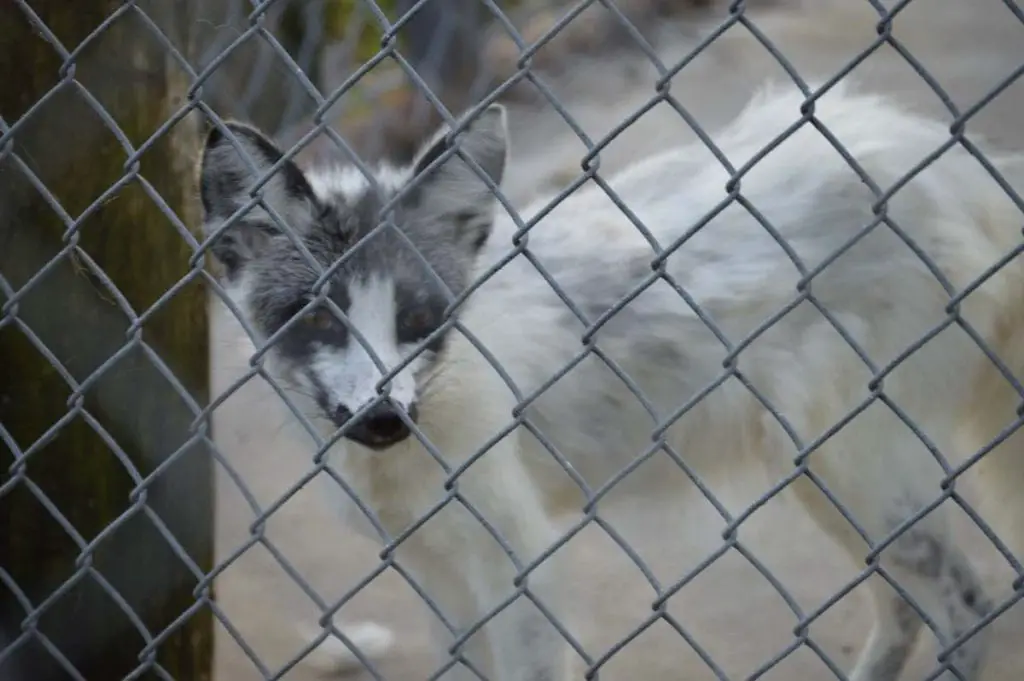
Conclusion
With all of the different species and subspecies of foxes, it is no wonder that so many of them exist throughout the world. They have truly left their footprints in the galleries of nature and will continue to exist with their resilient adaptations that make certain they will survive.
FAQ
What foxes come from islands?
The island fox is related to the gray fox and is thought to be one of the oldest fox species in the world.
Are there undiscovered species of foxes?
This is quite possible since there are many regions in the world that have not yet been fully explored.
Was the Darwin’s fox discovered by Darwin?
Yes, the Darwin’s fox was discovered by Darwin while he was at San Pedro island off the coast of Chile in 1824.
Can foxes mate with dogs?
No foxes are unable to mate with dogs due to them being a different species and not having the same chromosomes.

